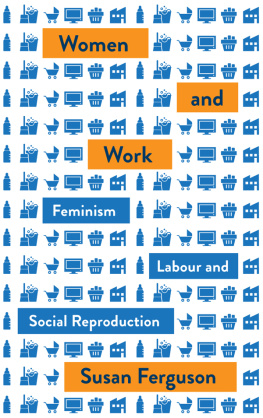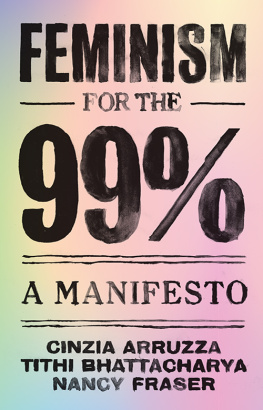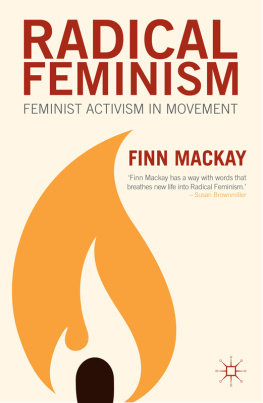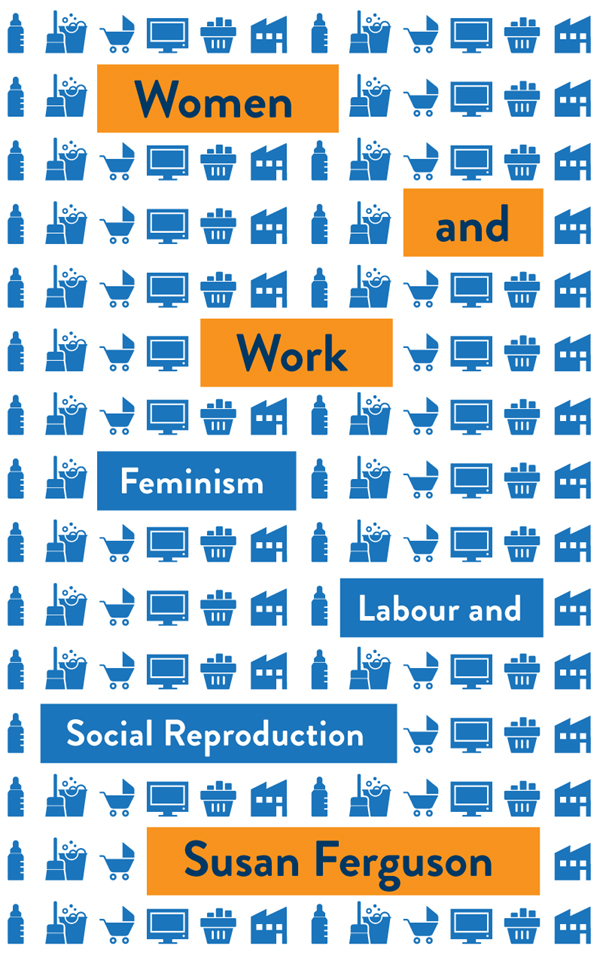Contents
Guide
Women and Work
Mapping Social Reproduction Theory
Series editors Tithi Bhattacharya, Professor of South Asian History and the Director of Global Studies at Purdue University; and Susan Ferguson, Associate Professor, Faculty of Liberal Arts, Wilfrid Laurier University
Capitalism is a system of exploitation and oppression. This series uses the insights of Social Reproduction Theory to deepen our understanding of the intimacy of that relationship, and the contradictions within it, past and present. The books include empirical investigations of the ways in which social oppressions of race, sexuality, ability, gender and more inhabit, shape and are shaped by the processes of creating labour power for capital. The books engage a critical exploration of Social Reproduction, enjoining debates about the theoretical and political tools required to challenge capitalism today.
Also available
Social Reproduction Theory:
Remapping Class, Recentering Oppression
Edited by Tithi Bhattacharya
Women and Work
Feminism, Labour,
and Social Reproduction
Susan Ferguson

First published 2020 by Pluto Press
345 Archway Road, London N6 5AA
www.plutobooks.com
Copyright Susan Ferguson 2020
The right of Susan Ferguson to be identified as the author of this work has been asserted by her in accordance with the Copyright, Designs and Patents Act 1988.
British Library Cataloguing in Publication Data
A catalogue record for this book is available from the British Library
ISBN 978 0 7453 3872 9 Hardback
ISBN 978 0 7453 3871 2 Paperback
ISBN 978 1 7868 0427 3 PDF eBook
ISBN 978 1 7868 0429 7 Kindle eBook
ISBN 978 1 7868 0428 0 EPUB eBook
This book is printed on paper suitable for recycling and made from fully managed and sustained forest sources. Logging, pulping and manufacturing processes are expected to conform to the environmental standards of the country of origin.
Typeset by Stanford DTP Services, Northampton, England
Simultaneously printed in the United Kingdom and United States of America
For David.
Contents
Acknowledgements
The immediate inspiration for this book came from a chapter I was asked to contribute to The Bloomsbury Handbook of 21st-Century Feminist Theory. So my first thank you is to Robin Truth Goodman, that books editor, for nudging me to figure out that there was a story to tell about feminist thinking about labour. But it would take more than 6500 words to do it greater justice. I want to thank David Shulman at Pluto for picking up on my enthusiasm for the book, and understanding as I lay aside (for now) a project on childhood and capitalism I have also planned with Pluto. I am grateful for his guidance through the proposal process and beyond, and throughout the launch of the Social Reproduction Theory book series. Neda Tehrani at Pluto has also been a pleasure to work with, and her feedback reassuring and valuable. I have worked through some of the ideas in the book at various Historical Materialism conferences, and am especially grateful to my co-organizers of the London HM Marxist Feminist stream for ensuring space is carved out every year to keep these and other socialist feminist discussions alive. I also want to acknowledge the Faculty of Liberal Arts at Wilfrid Laurier University for support given to my research over the years, this last year especially while I was on sabbatical leave.
I have been inspired and supported by many friends, colleagues, comrades, and family members. To single out a few: Alan Sears, for our fun and far-ranging chats at Page One that helped shaped my thinking; I also want to thank Alan along with James Cairns for their always thoughtful, probing feedback on earlier chapters; Karley Doucette for our discussions about socialist feminism, the Handmaids Tale, and the papers we heard at the Marxist Institutes Summer School in Albany; Mary-Jo Nadeau for lending me her MA thesis and for her unflagging political activism and wisdom; Sam Ferguson, one of my amazing sons, for his insightful comments on early chapters, as well as for patiently seeing me through computer and internet transitions and glitches; my other amazing sons, Liam and Adam McNally, and my sisters, Anne and Karen, for their love and support; Anne gets honourable mention for feeding me delicious dinners at critical junctures as my deadline approached and no one was home to cook for me; and a big thank you to Tithi Bhattacharya, who has done so much to advance and publicize the ideas and political commitments of social reproduction feminism over the past decade, for her valuable feedback on and enthusiasm for this book, as well as for our ongoing collaboration on this book series and other projects.
Finally, I dont have the words to adequately thank David McNally. I can only say that without him, this book would not have been written. Throughout its writing, despite huge changes in our lives as we uprooted and moved from Toronto to Houston, he gave unfailingly of his time, insight and wisdom, his love and support. Thank you sweetie.
Introduction
When Hillary Clinton won the Democratic presidential nomination in July 2016, it was widely seen as a triumph for feminism. Clinton had climbed up the patriarchal ladder in the 1970s and 1980s, smashing glass ceilings along the way to become a wealthy lawyer, New York state senator, and eventually US Secretary of State in the Obama administration. She seemed the very picture of a working woman who had made it in a mans world. As former Texas senator Wendy Davis told the Democratic Partys womens caucus at the time, We have never, ever had someone who has walked in our shoes, we have never had someone who understands what it means to be a woman in America, and we have never had the kind of champion that we are going to have in Hillary Clinton.
Alas, Clinton didnt fare as well in her next job interview. She lost the contest for president of the United States to a man. Not just to any man, but to one notoriously sexist Donald Trump. It looked like Americans would accept almost anything to keep a woman out of the White House. Just as feminism propelled Clinton forward, her supporters lamented, anti-feminism stopped her in her tracks.
Yet, a few months later, the wind was fully in feminisms sails, albeit blowing in a different direction. In January 2017, hundreds of thousands marched through city streets around the world, waving placards with angry, witty quips at Trumps outrageously loutish behaviour and warning that feminisms hard-fought gains will not be easily dismantled. Then on March 8, International Womens Day (IWD), they took to the streets again responding to a call to resist not only Trump and his misogynist policies, but also the conditions that produced Trump, namely the decades long economic inequality, racial and sexual violence, and imperial wars abroad.
This was a differentbut not entirely newdirection for feminist politics. Socialist feminists who organized international Womens Strikes to coordinate with IWD demonstrations did what feminists in Latin America, Italy, and Poland had been doing in recent years, and what feminists have done during upsurges of struggle throughout history: they called on women to striketo walk off their waged and unwaged jobs, Such resistance looks very different from vying for a seat in a boardroom or the oval office for a good reason: these feminists aim not to break into a mans world, but to change that world by collectively refusing the work that upholds it.












